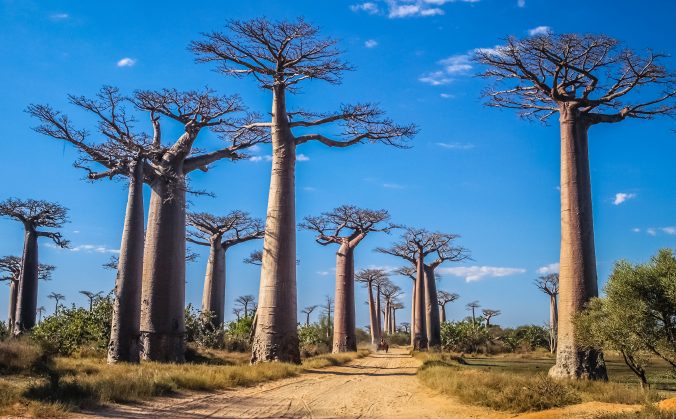The remnants of what was once a more extensive forest.
There are few avenues were people drive out just to see at sunset, but the Avenue of the Baobabs at Morondava draws admirers from all over the world. A dusty road half an hour’s drive north of the town of Morondava on the west coast of Madagascar passes through a stunning grove of baobabs, the remnants of what was once a more extensive forest.
The famous Avenue of the Baobabs has perhaps more than 100 trees in the grove. The species – the biggest and most famous of Madagascar’s six species of baobabs – is Adansonia grandidieri taking its name from two French naturalists Michael Adanson and Alfred Grandidieri.
These iconic trees, with distinctively cylindrical trunks, are the tallest of all the baobabs. They have massive, long, thick trunks and are deciduous, have smooth reddish-grey bark, and end in a concentration of short, crown-like, stocky branches at the top. They can reach 25 to 30 m in height and a circumference of 9.5m.
At certain times of the year the flat-topped crowns bear bluish-green palmate leaves, dark brown floral buds and spectacular white showy flowers that bloom for only one night. The fibrous wood stores water, and the diameter of the trunk fluctuates depending on rainfall.
The large, dry fruits of the baobab contain kidney-shaped seeds. These seeds and the vitamin C-rich fruit pulp are eaten fresh, cooking oil is extracted from the oil-rich seeds and can be made into sweets, porridge, a lemony drink and also roasted. The fruit is either collected from the ground, or wooden pegs are hammered into the trunk so the tree can be climbed to collect the fruit.
Coquerel’s dwarf lemurs feed on baobab leaves and flowers.
The spongy baobab wood consists of sheets of fiber that are collected from dead or living trees, dried in the sun and sold for thatch. Most of these varied uses do not involve the tree being killed, and are therefore unlikely to pose a threat to the baobab. The greatest threat to this species has come from the transformation of its forest habitat into agricultural land.
The Madagascar baobab is classified as endangered by the IUCN Red List. In 2003 the President of Madagascar vowed to triple the number of protected areas, a measure that may benefit the baobabs.
Baobabs provide important habitat for a variety of invertebrates, birds, reptiles, and mammals. Red-tailed lemurs and Coquerel’s dwarf lemurs feed on its leaves and flowers. The trees are pollinated by nocturnal pale fork-marked lemurs and Madagascar straw-coloured fruit bats. Birds, such as green sunbirds and the Souimangas sunbird, enjoy the nectar; parrots and guinea fowl eat the seeds.
